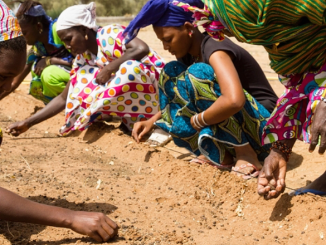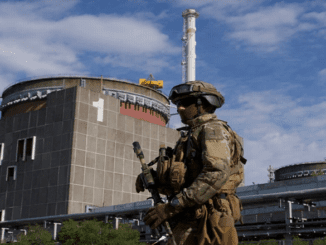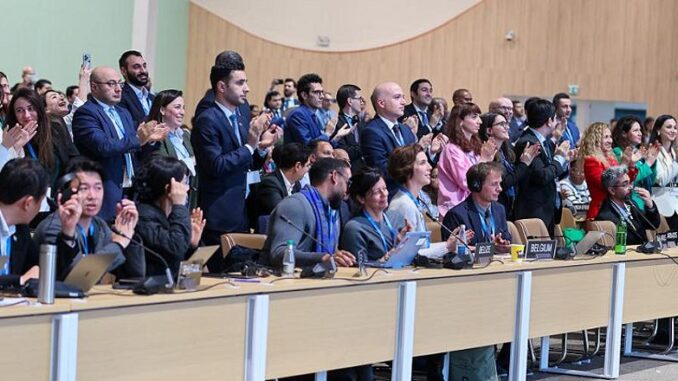
BAKU, Azerbaijan, November 25, 2024 (ENS) – At the COP29 UN Climate Change Conference in Baku, which wrapped at dawn on Sunday, governments agreed on a new collective annual climate finance goal that triples the current US$100 billion a year goal under the 2015 Paris Agreement.
Developed countries agreed to raise at least US$300 billion a year by 2035 to assist poorer countries, which emit very few climate-harming substances but often suffer the worst effects of the warming climate: hurricanes, cyclones, wild winds, droughts, floods, landslides, and sea level rise.
The COP29 event in Azerbaijan, a Caspian region petrostate, attracted 72,000 registered participants from 196 countries to the two-week-long meeting – 80 presidents, vice presidents, and prime ministers among them. Yet, European Commission President Ursula von der Leyen, French President Emmanuel Macron, and Russian President Vladimir Putin also skipped COP29. So did U.S. President Joe Biden and Chinese President Xi Jinping who were both in Peru for the Asia Pacific Economic Cooperation summit.
Delegates from vulnerable countries criticized the new US$300 billion a year finance goal, warning that the amount fails to cover their urgent needs. The wealthier nations agreed to try and scale this amount up to US$1.3 trillion a year through public and private sources over the same period, although the draft agreement does not detail how this would be accomplished.
This was a key EU demand “to ensure that other countries do their fair share in providing and mobilizing funding, matching their financial capacity,” the European Commission said in a statement.
There is no assigned share of this contribution for the EU, its Member States, or any other country. Decisions about how to meet these targets will rest with the government Parties to the Paris Agreement.
This legally binding international treaty on climate change was adopted by 196 Parties at the UN Climate Change Conference, COP21, near Paris, France, on December 12, 2015. It entered into force on November 4, 2016.
The delegates at COP29 set a goal of at least US$300 billion per year by 2035 for aid to developing countries from a wide variety of sources, public and private, bilateral and multilateral, including alternative sources, with developed countries taking the lead, and developing countries encouraged to make contributions on a voluntary basis.
Though it’s a petrostate, Azerbaijan has declared its commitment to developing its renewable energy potentia – an important part of the country’s plan to reduce greenhouse gas emissions by 40 percent by 2050. The country intends to increase renewable power capacity to 30 percent by 2030 and diversify its existing energy system to become a leader in green energy. Azerbaijan is committed to leading by example and will update its national targets in its next 1.5-aligned Nationally Determined Contribution.
COP29 delegates reached a breakthrough agreement that will:
- – Triple finance to developing countries to US$300 billion annually by 2035, up from the previous goal of US$100 billion annually.
- – Secure efforts of all actors to work together to scale up finance to developing countries, from public and private sources, to the amount of US$1.3 trillion per year by 2035.
- – Known formally as the New Collective Quantified Goal on Climate Finance, or NCQG, this target was agreed by governments after two weeks of intensive negotiations and several years of preparatory work, in a process that requires all nations to unanimously agree on every word of the agreement.
“This new finance goal is an insurance policy for humanity, amid worsening climate impacts hitting every country,” Executive Secretary of UN Climate Change Simon Stiell said. “But like any insurance policy – it only works – if premiums are paid in full, and on time. Promises must be kept, to protect billions of lives.”
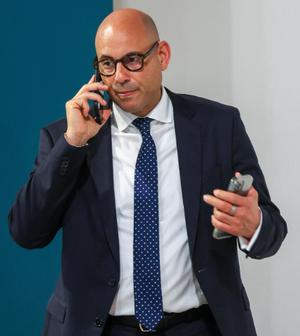
“It will keep the clean energy boom growing, helping all countries to share in its huge benefits: more jobs, stronger growth, cheaper and cleaner energy for all,” Stiell said.
After years of aspirational discussions, delegates at COP26 in Glasgow, Scotland launched an ad hoc work program, which ran until COP29 in 2024, to initiate the deliberations on the New Collective Quantified Goal on Climate Finance.
The new finance goal at COP29 builds on global climate action at COP27 in 2022, which agreed an historic Loss and Damage Fund, and COP28, last year, which delivered a global agreement to transition away from all fossil fuels in energy systems swiftly and fairly, triple renewable energy and boost climate resilience.
As a harbinger of potential success, the International Energy Agency expects global clean energy investment to exceed US$2 trillion for the first time in 2024.
While President Joe Biden was in Peru at another international conference and did not attend COP29, he congratulated the COP29 negotiators for their NCQG climate finance agreement.
“Together, countries set an ambitious 2035 international climate finance goal. It will help mobilize the level of finance – from all sources – that developing countries need to accelerate the transition to clean, sustainable economies, while opening up new markets for American-made electric vehicles, batteries, and other products,” President Biden wrote on the White House website.
“In Baku, the United States challenged countries to make an urgent choice: either consign vulnerable communities to ever more catastrophic climate disasters, or step up and place all of us on a safer path toward a better future,” President Biden said.
The United States was an initial signer of the Paris Agreement, but former President Donald Trump had pulled the country out of the treaty. President Biden restored U.S. membership.
“On my very first day in office [January 20, 2021], I took action to return the United States to that agreement, restore America’s global climate leadership, and recommit to international climate ambition,” Biden wrote.
“Since then, my administration has leveraged our nation’s leadership on climate action at home to accelerate global efforts – including at COPs 26, 27, and 28 – to reduce emissions, lower energy costs, create good-paying jobs, protect ecosystems, and strengthen resilience – all of which has also helped grow our economy.”
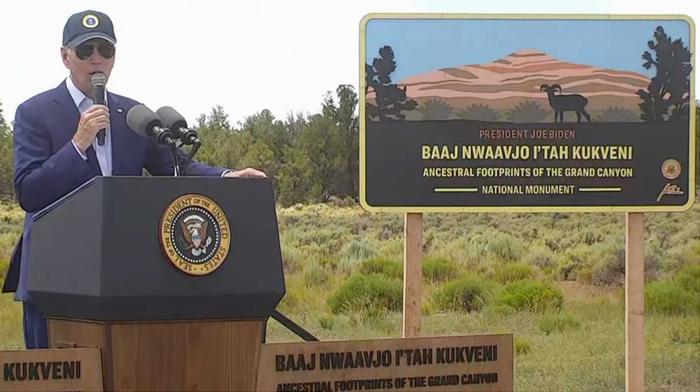
“In the years ahead, we are confident that the United States will continue this work: through our states and cities, our businesses, and our citizens, supported by durable legislation like the Inflation Reduction Act, the largest investment in climate and clean energy in history,” the President wrote.
And Biden had a word for the climate deniers about the path to cleaner energy that the world is now taking. “While some may seek to deny or delay the clean energy revolution that’s underway in America and around the world, nobody can reverse it – nobody,” Biden declared.
“I congratulate the Parties and the COP29 Presidency on reaching this outcome,” Biden wrote. “While there is still substantial work ahead of us to achieve our climate goals, today’s outcome puts us one significant step closer. On behalf of the American people and future generations, we must continue to accelerate our work to keep a cleaner, safer, healthier planet within our grasp.”
NCQG Pries Open New Sources of Funding
The adoption of N-C-Q-G, a New Collective Quantified Goal for Climate Finance, has broadened the global contributor base for financing climate help for developing countries.
Detailed in an accompanying decision to the Paris Agreement, is the New Collective Quantified Goal (NCQG) for climate finance prior to 2025. This new goal is to be built on the developed countries’ commitment of the US$100 billion per year by 2020 and must consider the needs and priorities of developing countries.
The original goal of US$100 billion was a political move to rebuild trust among the developed countries Parties to the Paris accord; it was not scientifically based nor derived from the needs of developing countries.
In 2009 in Copenhagen, Denmark, developed countries committed to provide or mobilize $100 billion per year in international climate finance by 2020. The Paris Agreement extended the target, so contributing countries were to meet the $100 billion target each year through to 2025.
Although the 2009 Copenhagen agreement stipulated that funding would be “new and additional,” developed countries, through the Organization for Economic Cooperation and Development, OECD, have only ever reported the simple total of climate finance.
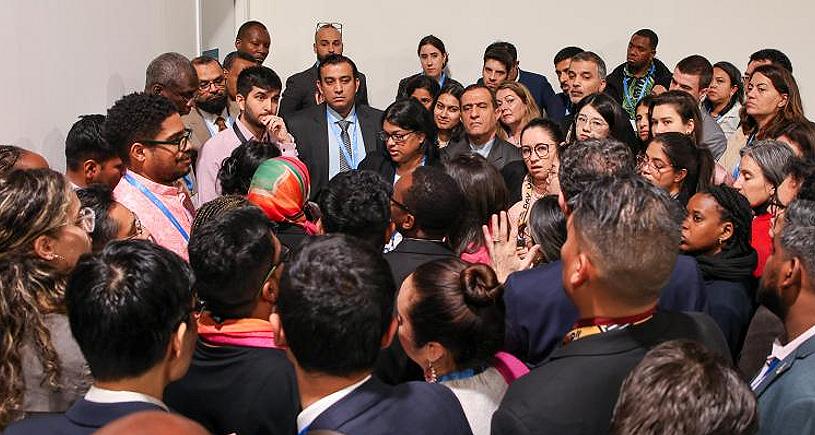
Measuring progress against the target is not yet a settled process. Among the open issues – no standard definition of what counts as climate finance, inconsistent reporting standards across donors, and a two-year lag on official data reported to the UN Framework Convention on Climate Change.
Now, the newly agreed NCQG provides for more countries to contribute financially, reflecting their growing climate-heating emissions as well as their economic advancements.
Within this broader target is a commitment by developed countries to take the lead on mobilizing US$300 billion per year by 2035 for developing countries’ climate action.
This essential goal can be achieved through a wide range of sources, such as finance mobilized by multilateral banks and, for the first time, contributions from other countries.
Multilateral Development Banks Take on More Climate Commitments
The NCQG agreement gives a strengthened role to multilateral development banks, maximizing the leverage and impact of public funds by drawing in and mobilizing private finance.
The World Bank is playing an organizing role in raising support for developing countries to cope with the changing climate.
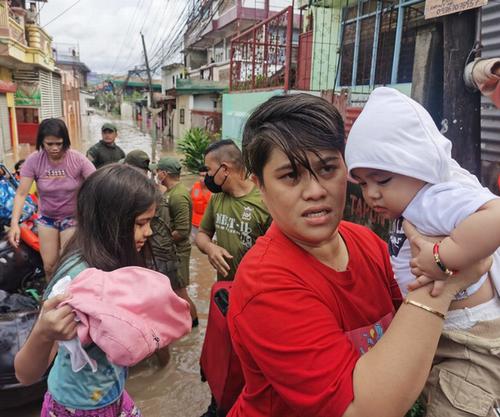
“Climate change is the greatest threat to health and wellbeing facing the world in the 21st century. The climate crisis is estimated to push 132 million people into extreme poverty by 2030 – one-third of these will be driven by the impacts of climate change on health alone. Despite the outsized impact, current investments in the nexus of climate change and health are extremely low,” the World Bank said in a July statement.
“Partnerships across institutional and sectoral boundaries” will help “to identify the most impactful and cost-effective solutions,” that will increase and prioritize investments at the scale needed to “sustainably finance climate and health action,” the World Bank said.
The Development Bank Working Group for Climate-Health Finance, established in July 2023, includes both multilateral development banks and public development banks. This group’s goal is to support countries to respond to the health impacts of climate change and elevating the health sector’s role in climate change adaptation and mitigation.
The new Roadmap for Climate-Health Finance and Action of the Development Bank Working Group, adopted in July, outlines a common, strategic approach to urgently raise, prioritize, and drive climate and health commitments to finance a people-centered approach for climate and health action.
Asian Development Bank Opens Glaciers Preservation Effort
With temperatures in Central Asia projected to rise by up to six degrees Celsius by 2100, the loss of glacial mass in the region threatens the fragile balance of these ecosystems, jeopardizing water supply for agriculture and hydropower, and risking the livelihoods of more than 380 million people.
At COP29, the Asian Development Bank launched a new regional program, Glaciers to Farms, that will promote sustainable water use and food security in Central Asia, the South Caucasus, and Pakistan as the region experiences the impacts of accelerated glacial melt due to climate change.
Supported by the Green Climate Fund’s Project Preparation Facility, the Asian Development Bank will conduct risk assessments of glacial melt in four nations: Azerbaijan, the Kyrgyz Republic, Tajikistan, and Uzbekistan – forming the scientific and technical basis for the Glacier to Farms program.
Signatures on this agreement include:
- – COP29 President and Azerbaijan Minister of Ecology and Natural Resources Mukhtar Babayev;
- – Kazakhstan Minister of Ecology and Natural Resources Yerlan Nyssanbayev;
- – Kyrgyz Republic Minister of Natural Resources, Ecology and Technical Supervision Meder Mashiev;
- – Tajikistan Committee on Environmental Protection Chairman Bahodur Sheralizoda; and
- – Uzbekistan Minister of Ecology, Environmental Protection, and Climate Change Aziz Abdukhakimov
- – Asian Development Bank President Masatsugu Asakawa and
- – Green Climate Fund Chief Investment Officer Henry Gonzalez
“As melting glaciers change waterflows, disrupt lives, and destroy ecosystems, we must act now,” said Asakawa. “As Asia and the Pacific’s climate bank, we are pleased to be joined by key partners to launch this program to drive international collaboration and deliver results where they matter most – on the ground, in communities at risk.”
Pakistan’s Minister of Finance Muhammad Aurangzeb and Georgia’s Minister for Economy and Sustainable Development Genadi Arveladze also attended the COP29 side event.
Glaciers to Farms envisages mobilizing up to US$3.5 billion from the Asian Development Bank, the Green Climate Fund, governments, development partners, and the private sector.
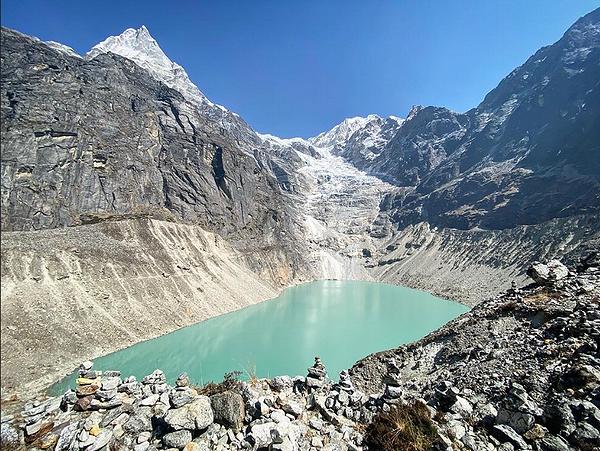
In addition to water and agriculture investments, the program will support vulnerable communities threatened by glacial melt, particularly in fragile mountain regions.
“The GCF recognizes the regional Glaciers to Farms program as a vital initiative to enhance climate resilience and promote sustainable development,” said Gonzalez. “Recognizing the profound vulnerability of mountain communities and ecosystems, this program is instrumental in safeguarding our precious water resources and empowering those most at risk.”
“This program embodies the essential collaboration and innovative strategies needed to address the severe challenges posed by climate change,” he said. “Together, we can build a resilient and sustainable future for all – especially for the vulnerable populations who depend on our mountain landscapes.”
Glaciers store freshwater that melts gradually, feeding rivers that support agriculture, hydropower, and drinking water across national borders. In upstream areas, shrinking glaciers diminish water flow, impacting local agriculture and increasing water shortages. Downstream, increased glacial runoff can cause floods. As glaciers continue to shrink, both upstream and downstream communities face greater water and food insecurity, and more risk to critical infrastructure.
Glaciers to Farms is one of several Asian Development Bank initiatives to help Asia adapt to melting glaciers. In the Hindu Kush Himalaya, this bank is establishing early warning systems and climate-resilient infrastructure. In monsoonal South and Southeast Asia, the bank is enhancing resilience throughout entire river basins.
Article 6 – What’s That?
There was plenty of criticism of COP29 throughout the two-week meeting over lack of progress on a range of issues –
- – On the new finance goal, India, Bolivia, and Nigeria registered their concerns and characterized the goal as an “insult that did not represent developed countries taking the lead.”
- – The LDCs lamented the lack of ambition in light of developing countries’ needs, exclusion of loss and damage, and missing minimum allocation floors for the LDCs and SIDS.
- – Pakistan identified critical gaps in the overall package and called for a return to the negotiating table with renewed commitment.
- Least developed countries and the Alliance of Small Island States walked out of a Presidency consultation saying they had not been consulted on text revisions. They later returned to the talks.
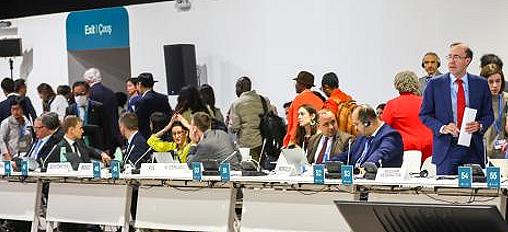
The European Union, Environmental Integrity Group, the Alliance of Small Island States, the Independent Alliance of Latin America and the Caribbean, and the Umbrella Group slammed the lack of progress on taking forward the outcomes of the Global Stocktake and urged rapid progress on energy transition. And Argentina pulled its delegation out of the conference –
Mohamed Adow, director of the Power Shift Africa thinktank, told The Guardian newspaper, “This [summit] has been a disaster for the developing world. It’s a betrayal of both people and planet, by wealthy countries who claim to take climate change seriously. Rich countries have promised to ‘mobilise’ some funds in the future, rather than provide them now. The cheque is in the mail. But lives and livelihoods in vulnerable countries are being lost now.”
But there were also advances. One COP29 achievement was the adoption of the decisions on Paris Agreement Articles 6.2 and 6.4. They put to work the market-based cooperative approaches for implementing the Paris accord.
Article 6 of the Paris Agreement recognizes that some Parties choose to pursue voluntary cooperation in the implementation of their nationally determined contributions to reducing climate change. This attitude can allow for higher ambition in countries’ mitigation and adaptation actions and can promote sustainable development and environmental integrity, the UNFCCC explains.
This week, under Article 6 of the agreement, COP29 negotiating teams finalized the rules on the environmental integrity, transparency and accountability of international carbon markets that trade in units of greenhouse gas emissions.
To get technical here for a moment, these units are known as ITMOs, Internationally Transferred Mitigation Outcomes. Each ITMO represents a ton of greenhouse gas reduced or removed from the atmosphere, which must be verified by an external entity to be eligible for trade.
A country that fails to meet its emission reduction targets according to its voluntary Nationally Determined Contribution can purchase ITMOs from another country that has achieved emission reductions beyond its national targets, as set out in its NDC.
This mechanism allows the selling countries that have achieved emission reductions beyond their domestic targets to profit from the sale of these ITMOs. And it allows the buying countries that have not achieved their targets to meet their emission reduction commitments.
Specifically, on the international registry provided for under Article 6.2, delegates found a potential landing ground that they could support – a “dual layer registry system.”
The international registry would form an “accounting layer” for tracking ITMO units. At the same time, the UNFCCC Secretariat would provide an optional service outside the registry with additional functions, including transfer and holding of units.
This registry solution has been in the works for a long time and marks an important milestone achieved in Baku. But while delegates applauded, the news was largely drowned out amid worry over other key outstanding issues, especially the new finance goal.
The crediting mechanism under Article 6.4 will set a new United Nations-backed standard for high-quality carbon offsets.
New rules for recording and tracking of international transfers is expected to bring transparency to bilateral carbon deals between Parties. “This will enable a cost-effective reduction and removal of emissions,” the European Commission said in a statement Saturday.
EU Gets Serious About the Climate
The EU is now the largest provider of international climate finance, contributing €28.6 billion (US$29.97 billion) in public climate finance in 2023 and mobilizing an additional amount of €7.2 billion (US7.5 billion) of private finance to support developing countries in their attempts to reduce their greenhouse gas emissions and adapt to the impacts of climate change.
Europe is the fastest warming continent in the world, and climate risks are threatening its energy and food security, ecosystems, infrastructure, water resources, financial stability, and people’s health, the European Environment Agency warns in a 2024 assessment issued to support strategic policymaking.
Extreme heat, drought, wildfires, and flooding, as experienced in recent years, will worsen in Europe even under optimistic global warming scenarios and affect living conditions throughout the continent. The EEA has published the first ever European Climate Risk Assessment, EUCRA, to help identify policy priorities for climate change adaptation and for climate-sensitive sectors.

With the European Green Deal presented in December 2019, the EU committed to reaching climate neutrality by 2050. This objective became legally binding with the adoption and entry into force of the European Climate Law, in July 2021.
The EU Climate Law also sets an intermediate target of reducing net greenhouse gas emissions by at least 55 percent by 2030, compared to 1990 levels. This 2030 target was communicated to the UNFCCC in December 2020 as the EU’s Nationally Determined Contribution, NCD, under the Paris Agreement.
In 2021, the EU presented a package of legislative proposals to make its climate, energy, land use, transport and taxation policies fit for reducing net greenhouse gas emissions by at least 55 percent by 2030.
During COP29 the EU joined a group of ambitious countries in announcing its intention to present a 1.5C-aligned NDC next year, setting the bar higher for other countries.
To drive forward the clean energy transition, the Commission and the Beyond Oil and Gas Alliance announced a partnership on the transition away from fossil fuels.
The Commission also launched a new Methane Abatement Partnership Roadmap to further accelerate the reduction of methane emissions associated with fossil energy production and consumption, in collaboration with a number of partner countries, international organizations, nongovernmental organizations and development banks.
This new Roadmap provides a blueprint for cooperation between fossil fuel importing and exporting countries, which will support companies in improving their monitoring, reporting and verification systems to reduce methane emissions. Under the Global Methane Pledge, launched by the EU and the United States, more than 150 countries are now implementing a collective goal of reducing global anthropogenic methane emissions by at least 30 percent by 2030, from 2020 levels.
These partnerships to accelerate the mitigation of methane emissions were announced by Commission President Ursula von der Leyen at COP28 in Dubai and build on the Joint Declaration from Energy Importers and Exporters on Reducing Greenhouse Gas Emissions from Fossil Fuels signed by the United States, the European Union, Japan, Canada, Norway and Singapore at COP27.
Following the COP29 launch of the Roadmap, the first examples of partnership implementation will be showcased at COP30 in Belem, Brazil.
During COP29, the EU published its first ever Biennial Transparency Report. The submission of these transparency reports is a milestone in the implementation of the Paris Agreement, enhancing accountability and collaboration in the global fight against climate change, as outlined under the Enhanced Transparency Framework of the Paris Agreement.
But COP29 delegates could not reach agreement on, among other issues, the dialogue on the implementation of the outcomes of the Global Stocktake and on the Just Transition Work Program. Discussions are expected to continue at meetings scheduled for June 2025.
The Earth Negotiations Bulletin concludes, “Trust will be needed to mend the carpets left bare in Baku. Headed to Belém in 2025, the task may be to salvage the legitimacy of the UN climate negotiations. With mounting questions about whether the Paris Agreement is fit for purpose, there is little time left to show its basic design can inspire countries to rise to the challenge of the climate crisis. Current NDCs will leave future generations with a 3°C warmer world.
As UNFCCC Executive Secretary Simon Stiell observed, this is better than where we were headed before the Paris Agreement, but it is far from a safe planet.”
Featured image: COP29 delegates celebrate the adoption of the New Collective Quantified Goal on Climate Finance (NCQG), November 23, 2024, Baku, Azerbaijan (Photo by IISD/ENB | Mike Muzurakis)
© 2024, Environment News Service. All rights reserved. Content may be quoted only with proper attribution and a direct link to the original article. Full reproduction is prohibited.

